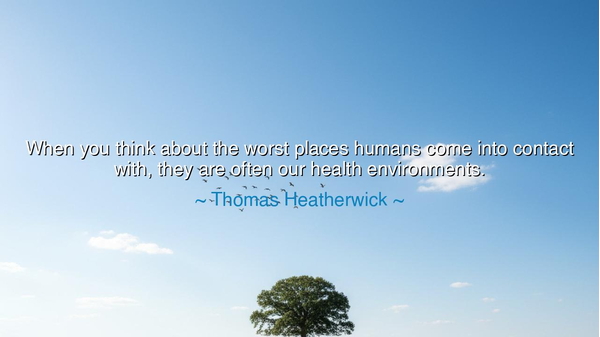
When you think about the worst places humans come into contact
When you think about the worst places humans come into contact with, they are often our health environments.






The visionary designer Thomas Heatherwick, known for shaping cities and reimagining human spaces, once observed: “When you think about the worst places humans come into contact with, they are often our health environments.” These words, though spoken in the language of modern design, strike at a truth far older than any civilization: that the places meant for healing have too often become places of coldness, fear, and disconnection. In them, the human spirit—already wounded—finds not solace, but sterility. Heatherwick’s words call us to remember that true health is not only the mending of the body, but the restoration of the soul.
In the days of the ancients, the healers of every culture understood that environment was a sacred part of the healing act. The temples of Asclepius in Greece were not cold and clinical—they were sanctuaries, filled with gardens, flowing water, and sunlight. The Egyptians built healing spaces beside the Nile, believing the rhythm of the river itself had power to calm the sick. Even in the East, where the masters of medicine studied balance and harmony, health environments were built as oases of tranquility. But in our modern age, we have replaced beauty with efficiency, and wonder with fluorescent light. The sick are placed in white-walled boxes where machines hum and humanity feels far away. Heatherwick’s lament is not merely about architecture—it is about the soul of care that has been forgotten.
He speaks as one who understands that our surroundings are not neutral; they shape the mind and therefore the body. To enter a hospital today is, for many, to feel smaller—to become a number, a case, a statistic. The walls do not whisper comfort, the light does not heal, and the air itself seems heavy with sterility. Yet human beings are creatures of feeling and perception; we respond not only to medicine, but to color, light, and form. Heatherwick’s insight arises from this timeless truth: that the environment can either deepen suffering or awaken the will to live. To heal a person, one must first remind them that they are human.
Consider the story of Florence Nightingale, the mother of modern nursing. When she tended to wounded soldiers in the Crimean War, she noticed that the conditions of their hospitals—dark, crowded, foul—were killing more men than their wounds. She demanded windows for sunlight, fresh air for the spirit, and cleanliness for dignity. Her changes reduced mortality and transformed the art of care. She understood, as Heatherwick does, that healing begins not with the pill or the scalpel, but with the space that welcomes the afflicted. A place of healing must feel alive, or else it becomes another battlefield where the human heart loses hope.
When Heatherwick speaks of “the worst places humans come into contact with,” he does not condemn medicine, but reminds us that our pursuit of technical mastery has outpaced our reverence for humanity. The rooms where life and death meet should not resemble prisons or factories. They should reflect the sacred nature of their purpose—the defense of life, the comfort of the suffering, the quiet dignity of being cared for. It is not enough to heal the body while wounding the spirit. Beauty, warmth, and humanity are not luxuries—they are medicines in their own right.
The meaning of Heatherwick’s words extends far beyond hospitals or clinics. It is a lesson for all who create, build, or serve. Whether in homes, schools, or workplaces, the environments we shape influence the souls who dwell within them. A dark, lifeless place breeds despair; a place filled with light and order breeds hope. The ancients called this harmony eudaimonia—the flourishing of life in its fullness. The same principle applies to the design of our health environments: to heal the body, one must also feed the senses, soothe the mind, and honor the spirit.
The lesson, therefore, is clear and eternal: healing begins with humanity. The true healer must be an architect of comfort as much as a giver of cures. Let every designer, doctor, and leader remember this—beauty is not mere decoration, but a force that strengthens the heart to endure and recover. We must reimagine our places of healing as sanctuaries once again, where architecture, art, and compassion work together to restore the wholeness of life.
So remember, O keeper of wisdom: the health environment is a reflection of the soul of the society that built it. If our hospitals are cold, our hearts must grow warmer; if our spaces are bleak, our spirits must create beauty. Let us return to the ancient truth that the body and the spirit are one, and that healing cannot thrive where humanity is absent. For when we design our world with care, we do more than build walls—we build hope. And in that hope, the human being, fragile yet magnificent, begins once more to heal.






AAdministratorAdministrator
Welcome, honored guests. Please leave a comment, we will respond soon